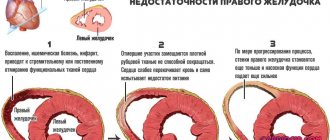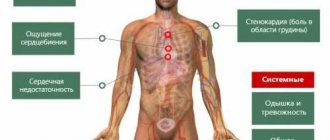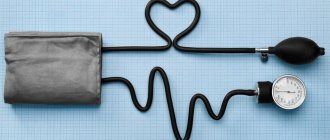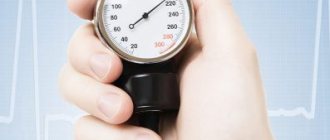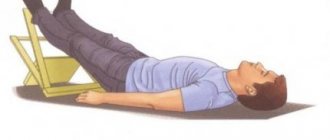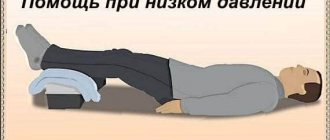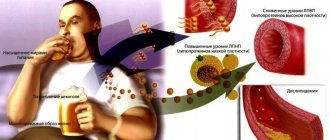Causes and danger of hypotension
Before considering first aid for hypotension, it is necessary to find out why such a pathology develops and what consequences it has.
Blood pressure decreases due to the fact that the heart muscle begins to contract weaker.
This deviation occurs for a number of reasons.
Modern medicine distinguishes primary, secondary and physiological hypotension. The latter species does not pose a danger to humans. Develops as a result of emotional and physical exhaustion. Primary hypotension is caused by constant mental stress, disrupted sleep and wakefulness, frequent stress and nervous strain.
Doctors note that primary hypotension is most often observed in children and adolescents who have high mental potential. The secondary type of disease is provoked by various deviations in the functioning of body systems. The chronic form of hypotension often occurs in weather-sensitive individuals. It is not uncommon for blood pressure to drop on very hot summer days or during rainy weather.
Hypotension is usually diagnosed in people with the following diseases:
- cervical osteochondrosis;
- liver dysfunction;
- dehydration of the body;
- pathologies caused by long-term use of medications;
- viral hepatitis;
- concussion and other head injuries;
- pathologies of the cardiovascular system;
- severe blood loss;
- dysfunction of the pancreas.
Low pressure is dangerous because the walls of the arteries begin to contract with low intensity. Because of this, the blood pumping process slows down significantly. Oxygen starvation and deficiency of elements necessary for the body lead to poor health and can cause cardiogenic shock. The risk of developing hypertension and stroke increases.
When you need quick help
Emergency care for hypotension is required when acute attacks occur. A sharp drop in pressure below 100/60 (for hypotensive patients - 80/40) poses a threat to life. The following symptoms are typical for such a critical condition:
- severe dizziness, weakness;
- pale skin;
- a pronounced feeling of lack of air;
- fainting;
- poor circulation in the extremities, causing them to become cold.
When blood pressure is low, the level of carbon dioxide increases and the level of oxygen decreases. Blood supply and nutrition to all organs also deteriorate, heart rhythm is disrupted, which can lead to cardiac arrest.
Alarming symptoms
Hypotension is considered to be a condition in which the tonometer readings drop: in men to the level of 100/60 mmHg, in women – to 95/60 mmHg and below. But this mark is considered relative.
The following nuances must be taken into account:
- Elderly patients often complain of feeling unwell when their blood pressure is at 120/80 mmHg. This value is accepted as the norm. But older people tend to have hypertension. They feel better at 140/60 mmHg;
- Blood pressure limits are influenced by the individual characteristics of the body. For some people, low blood pressure is normal and is not accompanied by unpleasant symptoms. With values of 90/60 mmHg, a person feels active and cheerful. And increasing the indicator to the standard causes his condition to worsen.
Low blood pressure is characterized by the following symptoms:
- hyperhidrosis;
- blurred vision;
- paleness of the skin;
- weakness;
- throbbing pain in the temple area;
- tachycardia;
- nausea;
- dyspnea;
- dizziness;
- migraine;
- fainting;
- darkening of the eyes when trying to stand up sharply from a sitting or lying position.
The above symptoms may appear due to physical overexertion. In this case, the condition quickly worsens. Without certain activities, a person may lose consciousness.
How to increase your blood pressure yourself at home
If low blood pressure is accompanied by rather unpleasant symptoms, it is better not to self-medicate, but to seek medical help. The doctor will prescribe the necessary studies and tests, and based on their results, select the appropriate medications for treatment.
If the numbers are not too low and there are no critical symptoms, you can try using home remedies, choosing the best one for yourself.
Regular table salt . It should be noted that it is contraindicated for hypertensive patients. Slowly dissolve a pinch in your mouth. You can simply eat something salty - a piece of herring or a pickled cucumber, a few pieces of cheese or a spoonful of rice with a lot of soy sauce.
Important. Constantly exceeding the amount of sodium in the body is fraught with heart problems.
Water . You can increase the circulating volume of blood in the vessels, and accordingly, the pressure, by drinking 2 glasses of water.
Shapewear . You can wear compression stockings designed for varicose veins. Stockings slightly reduce the volume of blood in the legs and displace it into the main vessels, thereby slightly increasing blood pressure.
If you don’t have stockings, cross your legs while sitting, or cross your thighs while standing and squeeze them tightly, the effect will be the same.
Drink a cup of quality coffee . It may only work on people who rarely use it.
First aid rules for hypotension
When a person's blood pressure drops sharply, it is better to call an ambulance. Before the doctors arrive, a number of measures must be taken. But first aid for low blood pressure should be provided in such a way as not to further worsen the patient’s condition.
The main principle of first aid for hypotension is not to harm the patient. Therefore, you should follow these rules:
- If unpleasant symptoms characteristic of hypotension appear, you need to measure your blood pressure using a tonometer. Only after making sure that the indicators for a person are low is it possible to take measures to increase blood pressure;
- It is impossible to sharply raise the values to the normal level. This will only make the situation worse.
If a person’s health has sharply deteriorated, signs of hypotension have appeared, certain measures must be taken urgently.
First aid for low blood pressure consists of performing a number of the following actions:
- Place the hypotensive patient in a supine position. You cannot put a pillow under your head. The lower limbs need to be raised to the level of the head to improve cerebral circulation. If you can’t get the patient to lie down, you can sit him up, bend your knees and gently lower your head between your knees;
- provide fresh air access to the room;
- To make it easier for a person to breathe, it is recommended to unfasten the top buttons of clothes and untie the tie. All tightening belts and jewelry must be removed;
- Sprinkle your face with water or wipe with a damp handkerchief. This is especially shown in the case when the pressure has decreased as a result of sunstroke;
- Give a glass of strong black or green tea with honey. You can add a little cinnamon powder for better effectiveness. The liquid should be warm (temperature 40-45 degrees). It is useful to drink pomegranate juice, coffee;
- give something salty to eat (cheese, cucumber);
- Give me half a tablet of aspirin to drink. A tincture of leuzea, eleutherococcus, lemongrass or ginseng is also suitable;
- a contrast shower, rubbing the whole body with a wet towel help to increase the tonometer readings;
- do an intense foot massage (from ankles to knees and above). You should rub your stomach and lower back. Massage the acupuncture point under the nose (press and hold it for a minute; repeat this 5-10 times);
- In case of fainting, ammonia helps well. It is sold at any pharmacy and is available without a prescription. You just need to give it a sniff. Essential oils are also effective. For example, camphor, mint, rosemary, bergamot. A couple of drops of the product should be placed on cotton wool and brought to the patient’s nose. A few breaths are usually enough for a person to come to his senses;
- Call emergency medical care or a local doctor at home.
To correct tonometer readings, pharmacists offer a number of drugs. But you should use them only after consulting a doctor. Citramon, Fludrocortisone, Cordiamin and Caffetin are good for raising blood pressure.
Regular Citramon effectively raises blood pressure
These medications must be taken under the control of tonometer readings. The dosage and method of administration are selected individually for each patient, taking into account the characteristics of the body and the severity of hypotension. If attacks of hypotension recur frequently, doctors usually prescribe a course of vitamin therapy.
After all, this condition is often observed with a deficiency of vitamins B and C. After stopping the hypotonic crisis, it is necessary to provide the patient with peace and rest. If the pressure drops sharply on the street, it is better to escort the person home.
Medicines to increase blood pressure
The following medications are used as first aid for low blood pressure:
- Cordiamin.
- Citramon.
- Kaffetin.
- Fludrocortisone.
The dosage and method of administration should be determined only by the attending physician for each case individually. At the same time, blood pressure indicators are monitored.
If attacks of hypotension recur, then vitamin complexes and drinking regimen are also prescribed. You must drink at least two liters of water per day.
Prevention
If there is a hypotensive person in the family, doctors recommend purchasing medications to increase blood pressure. By taking such medications at the first sign of an attack of hypotension, you can increase your blood pressure and improve your condition without calling an ambulance.
As a preventative measure, doctors recommend:
- increase salt intake;
- drink about two liters of liquid per day;
- eat small and often. Food should be rich in vitamins and microelements;
- exclude from the diet foods that contain large amounts of potassium. It is worth giving up garlic;
- walk in the fresh air more often;
- exercise. Physical exercise is recommended for at least twenty minutes a day.
Low performance
If the number of heart contractions decreases, the pulse decreases along with the pressure.
Most often, low blood pressure and low pulse are inseparable concepts. A disease in which such changes in the cardiovascular system are observed is called bradycardia.
When the first symptoms appear, you need to get diagnosed as quickly as possible and consult a doctor about possible treatment.
If you can't see a doctor immediately, help with a low heart rate can be provided at home.
First of all, it is necessary to find out the reasons that reduce such important parameters for human health. Then you need to drink several cups of any tonic drink, which will slightly increase your blood pressure.
Guarana or ginseng extract also increases heart rate, that is, pulse.
Remember!
These drugs are strictly prohibited for high blood pressure in hypertensive patients.
Special cases
A pregnant woman often experiences periods when, with an increased pulse, a decrease in pressure is observed. This is due to both individual predisposition and hormonal changes in the body.
As a rule, drug treatment is rarely resorted to during this period. However, the expectant mother should definitely consult with her doctor to avoid possible complications.
In order to stabilize the condition, women must follow the following recommendations:
- Correctly alternate the time of sleep and wakefulness;
- Eat well;
- Walk a lot in the fresh air.
With a high heart rate, it is advisable to devote more time to proper sleep, which will not only normalize the indicators, but also improve the general condition of the pregnant woman.
Alternative methods
If immediate medical intervention is not required, you can increase the desired parameters at home with the help of a contrast shower or neck massage, which is performed manually or using special massagers.
In addition, these two methods can be combined: direct a stream of cool water to the neck area, and after a few minutes increase its temperature. With the help of this alternation of contrasting water temperatures on the neck area, improved blood flow and increased pressure are achieved.
A decrease in important cardiac parameters signals problems with the cardiovascular system. That is why it is important to know what to do with low blood pressure in order to prevent more serious consequences for human health and life.
Useful video
If you are worried about low blood pressure, what should you do? First aid for hypotension consists of the following points:
Thus, if among your relatives and friends there is a hypotensive person, it is useful to know the symptoms of low pressure and the algorithm of actions in the event of an attack of hypotension. If the pressure drops sharply, you need to call an ambulance and take a number of measures to improve the patient’s well-being before the doctors arrive. To prevent frequent crises, you should lead a healthy lifestyle, eat a certain way and drink enough pure mineral water.
- Eliminates the causes of pressure disorders
- Normalizes blood pressure within 10 minutes after administration
Statistics show that the number of diseases of the cardiovascular system is increasing every year. There are many reasons for this. This is the environmental situation, the rhythm and way of life of people and the fact that many are indifferent to their health. An important prevention of the diseases listed above is control of blood pressure (BP). After all, knowing what indicators are normal and at what pressure to call an ambulance, you can protect yourself and your loved ones from many complications.
For what reasons does blood pressure most often drop?
There are two main types of arterial hypotension – physiological and pathological. In the first case, the patient feels absolutely normal, he does not express any complaints, since the indicators are quite normal for him. In such a situation, assistance is not required. If low blood pressure is a sign of a specific disease, the clinical picture includes additional symptoms that significantly impair a person’s quality of life, suggesting a concomitant disease.
Primary, or essential hypotension develops for reasons that are inexplicable to modern medicine. Doctors suggest the influence of a sum of factors: individual genetic characteristics, reduced (sometimes increased) physical activity, excessive emotional and mental stress, poor nutrition.
When the cause of hypotension is a specific disease, we are talking about secondary (symptomatic) hypertension, which develops as a result of:
- vegetative-vascular dystonia;
- spinal cord injuries and diseases;
- endocrine disorders (hyperthyroidism, hypoglycemia, Addison's disease);
- taking certain medications or poisoning with them (most often occurs with an overdose of drugs to treat a hypertensive crisis);
- dehydration due to fever, prolonged vomiting or diarrhea, increased sweating (hyperhidrosis);
- infectious diseases;
- allergic reactions;
- acute or chronic blood loss;
- fasting (postprandial hypotension).
A special type of this condition is considered to be orthostatic hypotension, in which symptoms of low blood pressure appear with a sudden change in body position, for example when standing up. The condition is more common in older people.
What is blood pressure and what are the blood pressure standards?
Blood pressure is an important physiological indicator that shows with what force the flow of blood moving through the vessels puts pressure on them. The volume of blood that the heart is capable of passing through itself per unit of time is displayed in this indicator.
To obtain a blood pressure reading, you need to record two of its parameters:
- Systolic blood pressure. It is also called upper pressure. This parameter corresponds to the pressure in the blood vessels when the heart muscle pushes blood into the arteries during compression.
- Diastolic blood pressure (lower pressure). Shows what pressure the blood exerts on the vessels during maximum relaxation of the heart muscle.
Each person has their own blood pressure standards
Normal pressure is generally considered to be 120/80 mmHg. Art. But depending on the age group and gender, this indicator may differ slightly.
Under the influence of various factors, for example, emotional state, time of day, physical activity, age, blood pressure may also change.
If a significant deviation from the norm is recorded in combination with other symptoms, we may be talking about serious diseases of the cardiovascular system.
Normal pressure and permissible deviations
It has been established that for a healthy middle-aged person the most optimal pressure is 120/60 mmHg. These are comfortable indicators at which the cardiovascular system functions in the correct mode.
Moreover, the limit of permissible deviation is a fluctuation of 10 units in both directions. However, such a change to higher values is also not critically dangerous. They simply take the human body out of its comfort zone.
The indicators are also influenced by many external factors: physical activity, nervous stress, bad habits. But if the body is healthy, the pressure normalizes when the negative impact disappears.
In addition, there are pathological conditions of the body in which the pressure at rest becomes below normal (hypotension) and above normal (hypertension).
Both diseases negatively affect the patient’s health and require qualified treatment.
The declared value varies depending on the age of the patient. Recommended permissible blood pressure values depending on age are shown in the table.
Indicators also differ between people of different genders. Women usually have lower values.
The difference between systolic and diastolic pressure is also important. It should be in the range of 30-55 units. A change in this value is an alarming signal about the development of pathological processes in the human body.
Knowing the norms and extremely acceptable values is very important. Deviations from these values can not only significantly affect the patient’s well-being, but also lead to his death.
At what low pressure should you call an ambulance, and what is the danger of arterial hypotension?
A condition in which blood pressure is lower than 100/60 mmHg. Art. is called hypotension or arterial hypotension.
In this case, the general condition of a person is characterized by:
- weakness,
- increased fatigue,
- dizziness,
- feeling of lack of air,
- increased sweating,
- darkening of the eyes, possible loss of consciousness.
The acute form of arterial hypotension occurs with severe oxygen starvation of brain tissue
These symptoms are explained by the fact that with hypotension there is a lack of blood supply, the brain and internal organs are subject to oxygen starvation.
People prone to hypotension often complain of low performance, inability to concentrate, and emotional lability. They are also prone to weather sensitivity and feel a deterioration in their general condition at low atmospheric pressure and cloudy weather.
Depending on the causes of the malaise, there are three types of hypotension:
- Physiological. Low blood pressure in this case is associated with fatigue, excessive physical activity, and lack of sleep.
- Primary. The main cause of hypotension in this case is a prolonged stressful situation, in which the body goes into a state of protection from external or internal negative factors. This also includes a hereditary predisposition to hypotension.
- Secondary. In this case, hypotension occurs against the background of more serious diseases, such as hepatitis, osteochondrosis, concussion, cardiac pathologies, thyroid dysfunction, neuroses, etc.
Often, in order to normalize the condition, it is enough to rest, drink a cup of coffee or actively walk down the street. If your health does not improve, and your blood pressure levels have dropped by less than 20%, then you are talking about low blood pressure, at which point you call an ambulance.
First aid for symptoms of low blood pressure
Before the ambulance arrives, it is necessary to carry out a number of activities that will help support a person during an acute attack of hypotension:
- Place the patient on his back, placing a bolster under his legs to elevate them;
- provide free access to air: open the window, unbutton your shirt collar, take off your tie;
- Give me drops intended for hypotensive patients. This could be a tincture of ginseng, eleutherococcus, or lemongrass. You can also give coffee or sweet strong tea to drink;
- actively rub and massage the leg muscles, starting from the ankles, and gradually rise to the hips;
- An effective means of increasing pressure is the method of contrast baths. To do this, you need to alternately dip your feet into basins with hot and cold water (you should always finish the procedure with cold water).
The application of these simple rules will help maintain the patient’s condition until the ambulance arrives, and sometimes even stabilize his state of health.
When to call an ambulance if you have high blood pressure, and what is the danger of hypertension
Arterial hypertension (hypertension) is a pathological condition in which blood pressure levels reach levels higher than 140/90 mm Hg. Art.
It is important to understand that high levels are dangerous to health, so it is highly not recommended to ignore this.
Associated symptoms of hypertension are:
- Headache that is pressing and throbbing in nature. When you tilt your head or have a strong cough, the pain may intensify.
- Aching pain in the region of the heart.
- A feeling of active heartbeat, which can radiate to the temples or limbs.
- Noise in ears.
- Nausea, vomiting.
- Visual impairment, spots before the eyes.
In this case, a great danger for the patient is a hypertensive crisis - an acute condition associated with a sharp and large increase in blood pressure, during which there is a huge load on all internal organs and the brain.
The cause of a hypertensive crisis can be excessive physical activity, prolonged exposure to heat, stress, or taking certain medications.
There is a list of factors that increase the likelihood of developing hypertension:
- overweight, obesity;
- sedentary lifestyle;
- diabetes;
- diseases of the cardiovascular system;
- thyroid dysfunction;
- abuse of energy drinks and other stimulants;
- changes in the spine;
- hormonal changes in women;
- neuroses, depression, etc.
First aid for high blood pressure
A person susceptible to a hypertensive crisis may experience convulsions and lose consciousness.
Therefore, it is important to immediately call an ambulance and begin carrying out manipulations aimed at smoothly lowering blood pressure:
- calm the patient down. During a hypertensive crisis, panic attacks often occur, which only aggravates the health condition;
- normalize your breathing. Performing simple exercises and conscious, controlled breathing will help with this;
- Place the patient on his back and ensure complete rest;
- Apply ice to your temples and hot heating pads to your feet. This will help normalize blood pressure;
- Give the patient a drug prescribed by his attending physician to lower blood pressure: “Farmadipine”, “Captopril”.
Understanding what blood pressure is normal and at what pressure you need to call an ambulance will help you maintain your health and avoid the dangerous consequences of a pressure surge. But it is much more important to understand that the condition of blood vessels and blood flow is actively influenced by a person’s lifestyle. You should not neglect ways to prevent hypertension and hypotension, because preventing the disease is easier than curing it.
Originally posted 2018-02-26 16:51:49.
The problem is that different people feel completely different with the same blood pressure numbers. Hypotonic people feel disgusting, at pressure that is quite comfortable for hypertensive people.
Therefore, if you feel discomfort and the pressure numbers are unusual for you, then you should call an ambulance.
we need numbers - I think we need to sound the alarm when the pressure is below 90/60 and above 150/90.
First, about the increase in pressure.
In one of the hospitals there was a poster on the information stand in which the critical pressure indicated an increase in pressure to 140/90. Once this level of pressure is reached, it is necessary to take measures to reduce it, which means, I think, we need to call an ambulance.
But, for example, I already feel bad with a blood pressure of 130/80. I start taking pills to lower my blood pressure at these levels. It was really bad at 140/90, but I didn’t call an ambulance, I took Capoten, it worked, then I took Corinfar in the morning for several days as a preventive measure.
And a friend of mine becomes ill at 160/100 and above, which is actually not good, since she does not notice the beginning of an increase in pressure and does not have time to take the medicine in time so that the pressure does not jump to 180/110 (and this happened). Another friend, also hypertensive with an increase in blood pressure that was unnoticeable to her, had her blood pressure rise sharply to 190/110, and had a stroke.
After this incident, I think that it is better to call an ambulance earlier than to later be treated for the severe consequences of a stroke. And the pressure must be constantly measured and kept under control.
And below are the symptoms of a hypertensive crisis, when an ambulance is simply necessary:
Low pressure.
Low blood pressure is also dangerous. Low blood pressure is defined as blood pressure below 90/60.
Low blood pressure is dangerous because the supply of oxygen to the brain, heart and other organs is reduced, hypoxia occurs, and blood circulation in small vessels and capillaries is impaired (peripheral circulation).
When the upper pressure reaches 60, a person may already lose consciousness. Therefore, an ambulance should be called if the pressure drops below 90/60 to prevent the development of complications.
When the pressure dropped, an ambulance was called twice to two elderly relatives. Both got sick at 80/50, one dropped to 70/45. The ambulance gave an injection of Cordiamine on the spot, the drop in pressure stopped, the patient was left under our observation (if anything happens, a second call with hospitalization). So far it's worked out.
Hypotension and hypertension are often confused with each other, although in fact they are completely opposite. But under certain factors, hypertension can develop into hypotension, and vice versa, hypotension into hypertension. At what pressure should you call an ambulance during pregnancy and in normal conditions? Let's look at this issue.
Medicines that increase blood pressure
Low blood pressure can be no less dangerous than high blood pressure, which everyone regularly talks about. With constantly low blood pressure, the brain and heart suffer from decreased blood flow; regular oxygen deprivation leads to dizziness and fainting. The risk of injury from a fall increases, and, accordingly, decreased performance.
To increase blood pressure you can take:
- A caffeine tablet (caffeine-sodium benzoate), if there is no result, you can take another one, just do not forget about the diuretic property of this drug.
- Two tablets of citramone, the drug will also relieve headaches.
To prevent a decrease in blood pressure, you can take the following pharmacy or home tinctures in long courses, for at least a month:
- Eleutherococcus.
- Ginseng.
- Schisandra.
You can achieve a short-term increase in blood pressure without using medications. Of course, this does not apply to critical cases that require rapid medical intervention.
How to distinguish hypertension from hypotension?
The main difference between these conditions is that with hypotension there is a decrease in blood pressure, and with hypertension there is an increase. Hypertension is associated with excitation of the sympathetic division of the autonomic nervous system. Hypotension is with excitation of the parasympathetic department. The main danger of hypertension is a sharp increase in blood pressure, which can lead to a heart attack, coma, or death. With hypotension, a critical decrease in blood pressure occurs, as a result of which the person’s heart can also stop. You need to study all the indicators to know at what pressure you need to call an ambulance.
Hypertension and hypotension can be distinguished by appearance. Doctors describe the portrait of a hypertensive person as follows: most often this person suffers from obesity, bad habits and prefers high-calorie foods. He leads a sedentary lifestyle, sleeps and rests little, and is often in stressful situations.
Hypotonics are described somewhat differently: this is a person with a thin body and eternally cold limbs. Has problems with appetite and breathing, often experiences dizziness, headaches and shortness of breath during physical activity.
There are blood pressure standards for people of different ages. When should you call an ambulance?
Most often, young people do not worry about what their blood pressure is, much less know little about its norms. Over the years, the body wears out and makes itself felt, then a person asks questions about blood pressure standards.
Minimum pressure readings
Average pressure reading
Maximum pressure readings
Sudden changes in blood pressure to a critical level can lead to death. In order to prevent the death of a loved one or not to die yourself, everyone needs to know what pressure indicators are critical.
The human body is individual, but many believe that a decrease in pressure by thirty points is dangerous. Experts do not give an exact answer to this question, but they think that the body cannot withstand blood pressure more than 260/140 mm Hg. Art. Then the person definitely dies. A sharp decrease in pressure leads to cardiac shock and certain discomfort, after which the heart muscle stops.
Hypertension causes frequent attacks. Most often, they are observed during stressful situations, mental and physical overload, as well as other factors. Increased blood pressure leads to the development of severe complications of the cardiovascular system. It happens that hypertension manifests itself critically. In this state, pressure often and sharply rises to 200/120 mmHg. Art. and higher. Only timely first aid can save the patient.
At what pressure should you call an ambulance? Doctors say that if the upper value is more than 160, then you should immediately consult a specialist, otherwise the risk of a hypertensive crisis is high. Then at what low pressure should you call an ambulance? If the indicator is less than 60, then the patient should seek medical help.
If we are talking about blood pressure during pregnancy, then in this case an ambulance should be called even with the most minimal surges and changes in well-being. There are no standard norms, since a woman’s body reacts differently. Uncontrolled surges in blood pressure can greatly affect the condition of a pregnant woman and her unborn baby. So, no self-medication is acceptable here and the question of at what pressure to call an ambulance during pregnancy is not worth it at all. You need to call her immediately.
Types of hypotension
There are several types of hypotension:
Orthostatic
The pressure drops when the body suddenly rises to a vertical position. When trying to get out of bed, a person feels dizzy and slightly lost coordination.
It most often affects older people, 65 and above. May appear during pregnancy and some neurological diseases.
Shy-Drager syndrome
Multiple system atrophy with orthostatic hypotension or myeloencephalopathy. The cause of this disease is disturbances in the functioning of the nervous system.
Unfortunately, the disease cannot be treated; life expectancy is sharply reduced and does not exceed 10 years from the time the disease is diagnosed.
Postprandial
Its peculiarity is a sharp drop in blood pressure immediately after eating. It is more common in people suffering from Parkinson's disease.
Dystonia
It is also known as vegetative-vascular hypotension - perhaps the most common variant of low blood pressure. It most often affects people who, due to their professional duties, are constantly in poorly ventilated, hot and stuffy rooms.
As a result, blood communication between the brain and heart is disrupted. Blood constantly rushes to the legs, and for the brain this is a bell about increased pressure. Accordingly, it signals the heart to decrease the heart rate, which in turn leads to a further decrease in blood pressure.
Dystonia most often affects children who have reached adolescence, the risk group is in the range of 12-18 years.
Increased heart rate with low blood pressure
This condition requires immediate contact with a therapist.
Emergency help for low blood pressure
If a hypotensive patient experiences increased drowsiness, weakness, rapid heartbeat, dizziness, nausea and faintness, then it is necessary to call an ambulance. While waiting for paramedics to arrive, do the following:
- It is necessary for the patient to quickly take a lying position without a pillow, with his legs elevated.
- If this is not possible, then you need to sit him down, bend his knees and gently lower his head between them. It is necessary for the patient to relax his muscles and sit in this state for at least 3 minutes.
- Breathing must be even and shallow.
- Provide fresh air into the room, loosen tight clothing on the patient.
- Give him a glass of strong tea or offer him a pickled cucumber.
- Rub the patient's legs vigorously, starting from the feet and moving towards the knees.
Emergency care for hypertension
To prevent hypertension from reaching a crisis, there are standards for providing care to patients. Doctors act according to these rules:
- To begin with, the patient is given a Nifedipine tablet under the tongue. This drug has a weak hypotensive effect and helps normalize blood flow.
- To lower blood pressure, the specialist administers Dibazol and medications belonging to the group of diuretics intravenously to the patient.
- If there are disturbances in the heart rhythm, beta-blockers are used. They are also administered intravenously or intramuscularly.
Rules to follow
Treatment of acute hypertensive crisis should be carried out exclusively in intensive care conditions.
- In case of complications, such as left ventricular failure, ganglion blockers are used. These drugs isolate nerve impulses in the ganglia, thereby reducing the load on the heart. Ganglioblockers and diuretics combine well.
- If there is a lack of coronary vessels, a very dangerous condition occurs. To make you feel better, Sustak and Nitrong are administered, combined with painkillers. If pain relief fails, narcotic drugs are used.
The main point of all therapy is to relieve symptoms and reduce the load on the heart.
What to do if you had to treat the disease at home?
How can you quickly provide first aid to a patient with hypertension if an attack occurs at home? If you do not help the patient in time, high blood pressure disrupts the nutrition of the kidneys, eyeballs, myocardium and brain, because the blood vessels are in a state of spasm.
Of course, emergency medical care is needed if a crisis develops. Stopping a crisis on your own can lead to serious complications, and these, in turn, to death. It is vital for the patient to call emergency services and know the following first aid steps.
How does low blood pressure manifest in humans?
Regardless of the cause of arterial hypotension, this condition is characterized by impaired vascular tone and a sharp weakening of cardiac activity.
As a result, the blood supply to brain cells decreases, which begin to experience oxygen starvation. The most common symptoms of low blood pressure include:
- dizziness, darkening and spots before the eyes;
- noise in ears;
- pale skin and increased sweating;
- nausea;
- tachycardia (rapid heartbeat), which occurs as compensation for the restoration of blood flow;
- headache;
- constant weakness, drowsiness, fatigue;
- syncope (loss of consciousness, fainting);
- menstrual cycle disorders in women.
With long-term hypotension due to chronic oxygen starvation of the brain, encephalopathy develops, which is characterized by impaired memory, concentration, and intelligence. Another dangerous complication can be traumatic brain injury after a fall due to frequent loss of consciousness.
In most cases, hypotension is characterized by a gradual development of symptoms, which allows you to notice signs of low blood pressure in time and provide first aid.
Normalize your breathing rhythm
The place where the patient is located must be ventilated. In order to stabilize the breathing rhythm, breathing exercises should be performed. Take a position that is comfortable for the patient. It is better to find a bed of medium hardness, and place the patient half-sitting. You can create this position using pillows.
You should apply something cold to your forehead for a couple of minutes, and to your feet, on the contrary, something warm. Take heart medications as prescribed by your doctor. Even if the medicine needs to be taken hourly, an extraordinary dose of the drug is used during an attack. For excruciating severe pain in the heart area, you need to take Nitroglycerin. If there is no result, 2 more tablets can be used, one at a time, with an interval of 10-15 minutes.
Reduce pressure
In order to lower blood pressure, you need to take antihypertensive drugs. Persistent blood pressure may decrease slightly, so you should take the drug again after half an hour. The patient must measure blood pressure approximately every 15-20 minutes. in order to track dynamics. Such strict monitoring will help determine the effectiveness of the medications taken.
If the measures taken do not bring relief, it is imperative to call emergency medical help. Information about all measures taken before the arrival of doctors will help specialists stabilize the patient’s condition in a short time.
At what pressure should we call an ambulance to stabilize it?
There is no need to try to stabilize the pressure in a couple of seconds, this will only make the situation worse. You should not take additional medications to quickly bring it to 120/80. If the pressure jumps to 220/120, it will be enough to reduce it to 160/100.
When all parameters are normalized, for prevention purposes you need to take tincture of hawthorn or valerian. And for the next 5 days it is recommended to continue taking them 1/2 tbsp. l., diluted in 1/3 tbsp. water, three times a day. If you notice problems with sleep or disturbances in your psycho-emotional state, you should consult a doctor.
On the first and second days after a hypertensive attack, you should avoid taking all medications except antibiotics and drugs with a hypotensive effect. First aid will help alleviate the patient’s condition during an attack, but you should still consult a doctor and get advice on further actions.
After an attack, headache, dizziness, and fatigue may occur. It is necessary to adhere to bed rest and avoid stressful situations.
Critically high blood pressure can lead to the failure of vital organs. Therefore, it is best to take care of your health and not bring yourself to such a state. And knowing at what pressure you can call an ambulance and how to provide first aid, you can avoid life-threatening situations.
About other methods to quickly increase blood pressure
First aid for very low blood pressure also includes the following effective methods:
- If the patient continues to feel unwell, you can quickly raise blood pressure by using a tincture of Eleutherococcus or ginseng root; just drop 20 drops of one of these remedies. If you use coffee or strong brewed tea instead of water, the effectiveness of the medicine will increase. But this is acceptable if the heart is healthy. In emergency situations, you can use lemongrass tincture. To raise blood pressure, add 10 to 20 drops of this product into water.
- Neck massage is also an effective first aid for hypotension. Of course, it is advisable that it be carried out by a specialist. But if you need to help a person, you can do the massage yourself. In this case, only stroking and rubbing movements should be used. It is forbidden to pat, pinch or hit the cervical-collar area, so as not to harm the cervical vertebrae. If you have special massagers at home, purchased at a pharmacy, you can use them. The massage lasts 10-15 minutes.
- To provide first aid, you can use acupuncture. The point is under the nose. The finger is placed on this point and pressed on it for one minute. Next, the finger is released and the procedure is repeated again (5 to 10 times).
- You can use hydromassage in the collar area. This can be done at home using a shower. To do this, the patient must bend over the bathtub. Then a stream of cool water is applied to the back of the head for one minute. Then the water temperature is set to 28 to 32 degrees and again flows onto the back of the head. After one minute, cool water is installed again and after 0.5 minutes the procedure stops. The cervical area is wiped with a towel. When performing a hydromassage procedure, you should not use cold water; this can lead to colds in the cervical lymph nodes and the development of acute lymphadenitis.
- You can increase your blood pressure by using contrast baths for your limbs. Place 2 basins, one should contain hot water, the other should have cold water. Lower your arms and legs first into one basin, then into the other. But the last one must be a basin containing cold water.
- Using alcohol to increase blood pressure is not recommended. With its help, you can dilate blood vessels and increase blood pressure, but after a day the patient will become worse due to the negative effects of alcohol on the nervous system and blood vessels.
If the pressure is low, it happens that it is easier to prevent it than to try to raise it later. To do this, you must follow the following recommendations:
- in the morning you need to have a good breakfast, and the food should be energy-rich;
- try to avoid stress during the day;
- sleep should be complete;
- to live an active lifestyle.
In this case, it is advisable to consult a doctor and determine the cause of low blood pressure.
People suffering from arterial hypotension are not as common as those with hypertension, however, problems with low blood pressure also have their place in medical practice.
Blood pressure levels can decrease for many reasons, for example, overwork or lack of sleep, and most often you can normalize it yourself and without the use of medications.
If a decrease in blood pressure occurs occasionally, accompanied by a slight malaise that goes away after proper rest, then there is no need to worry. But if attacks of arterial hypertension occur frequently or are chronic, you should not put off going to the doctor.
- All information on the site is for informational purposes only and is NOT a guide to action!
- can give you an ACCURATE DIAGNOSIS !
- We kindly ask you NOT to self-medicate, but to make an appointment with a specialist !
- Health to you and your loved ones!
A decrease in blood pressure is the result of a weakening or reduction in the impulse of the heart muscle, insufficient venous return of blood to the heart, as well as a deterioration in peripheral vascular resistance.
Low blood pressure is often caused by weak arterial walls, which, due to their inelasticity, stretch under the flow of blood, thereby impairing blood circulation.
Also, the mechanism of development of hypertension depends on the type of disease, which is divided into three types:
- occurs during intense physical exertion;
- during prolonged overexertion, the body, for the purpose of protection, switches to the function of economical energy expenditure, which leads to a weakening of the functioning of many systems, including blood circulation.
- develops as a result of prolonged stress;
- when nervous overstrain occurs, due to mental stress or anxiety, the body, protecting itself from serious consequences, changes the impulse signals of the brain to the heart, thereby reducing the functioning of the circulatory system.
- appears against the background of many diseases that have an unfavorable course or chronic etiology;
- this type of low blood pressure occurs due to prolonged fasting, hypovitaminosis, especially with a lack of vitamins E, B and C, as well as a sharp change in climate.
Most often, weather-dependent people suffer from a chronic form of hypotension; any change in weather conditions affects them with poor health due to low pressure.
The following reasons can provoke a decrease in blood pressure:
- cervical spine injuries;
- osteochondrosis;
- concussion;
- chronic hepatitis or cirrhosis of the liver;
- prolonged severe anemia;
- pancreatic diseases;
- thyroid dysfunction;
- medications (side effects);
- cardiac dysfunction;
- vascular atherosclerosis;
- long-term depression and neurotic state;
- dehydration or severe blood loss.
The main reason for the development of arterial hypotension can be considered poor vascular tone. In hypotensive patients, the arterial walls do not contract quickly enough, which slows down the pumping of blood and provokes malaise due to the fact that the body does not receive enough necessary nutrients and oxygen.
Poor health, with a decrease in blood pressure, occurs when the systolic pressure drops below 100 mm Hg. Art., and the diastolic becomes less than 60 mm Hg. Art.
In elderly people, ailments associated with hypertension occur at levels of 110/70 mm Hg. Art., since their normal blood pressure is considered to be 150/90.
Hypotension ailments may be accompanied by the following symptoms:
- headache;
- heat intolerance;
- sensitivity to cold;
- memory impairment;
- inattention;
- nausea (during acute attacks);
- dizziness accompanied by darkening of the eyes;
- fainting;
- chronic fatigue;
- drowsiness and weakness;
- low performance;
- predisposition to motion sickness;
- sweating of the feet and palms;
- lack of air;
- shortness of breath and palpitations during exercise.
The presence of specific symptoms depends on the type of arterial hypertension and its form. With chronic hypotension, pressure readings usually do not fall below 100/65 mmHg. Art. This type of illness does not lead to a significant deterioration of the condition, most often accompanied by mild dizziness, drowsiness and fatigue.
Help for such low blood pressure is to improve blood flow. A contrast shower with alternating hot and cool water helps to alleviate the condition and normalize blood pressure.
After taking a shower, you should drink a cup of sweet green tea or coffee. Also, with low blood pressure, dark chocolate or something salty helps a lot, since salt increases blood pressure.
Citrus fruits, pomegranate juice, and vitamin C will help cope with hypotension. To improve blood flow, you can massage the cervical-collar area, it will quickly accelerate the blood and help increase blood pressure.
First aid for low blood pressure of acute etiology primarily involves calling an ambulance.
Before the arrival of doctors, if a person has lost consciousness or is in a pre-fainting state, the following manipulations should be carried out:
- lay the patient horizontally (on his back);
- provide access to fresh air;
- free the neck and chest area from constricting clothing;
- give the patient drops for hypotension (if he is conscious);
- rub the leg muscles, starting to massage them from the ankles, moving up.
If you do not have the necessary medicine at hand to eliminate the hypotonic condition, then in order to raise the pressure, you can give the person strong coffee or give two tablets of citramon, which also contains caffeine.
It is necessary to remember about contraindications; try to find out from the patient whether he has heart disease and whether he can take blood-thinning drugs.
You can normalize blood flow and slightly increase pressure using the acupuncture method: press the point under the nose with your finger, hold for about a minute, then release and repeat the same manipulation again (5-10 times).
From here you can learn about the causes of orthostatic hypotension and how to treat it.
Also, while emergency assistance is on the way, you can normalize blood flow by placing the lower limbs above the level of the head. To do this, you need to lie down with your legs over the back of the sofa or sit on the bed and place several pillows under your shins.
First aid at home for low blood pressure is very important. If you put the patient to bed in time and give him medications that eliminate the symptoms of hypotension, you can avoid loss of consciousness and falling.
To treat low blood pressure, it is not necessary to resort to taking medications that have a lot of side effects and contraindications. In addition to traditional therapy for arterial hypertension, there is also an unconventional one, which consists in treating hypotension with traditional methods.
Let's look at some of them:
- with a slight decrease in blood pressure, you can eat a pinch of salt or drink salted water;
- salt increases blood pressure due to fluid retention in the body, therefore it is an effective traditional medicine;
- however, remember that the safe amount of this substance per day is 4–5 grams; if you eat more, you can harm your health.
- tincture from the root of this plant perfectly tones, strengthens the immune system and increases blood pressure;
- to get rid of a hypotonic state, it is enough to drink 35–40 drops of ginseng tincture, diluting it with half a glass of water.
- for chronic hypotension, taking 25 drops of lemongrass tincture before meals can prevent the acute manifestation of the disease and get rid of chronic fatigue and drowsiness;
- Do not drink lemongrass tincture at night to prevent insomnia.
- dried grapes increase blood pressure and improve the condition of the circulatory system;
- those who do not like this delicacy can make a tincture from it and drink it half an hour before meals.
- take strawberry leaves, St. John's wort, yarrow, juniper fruits and rose hips in equal quantities;
- pour boiling water (3 cups) over all ingredients and leave to steep in a warm place for a couple of hours;
- By drinking a tablespoon before meals, you can improve the elasticity of blood vessels, get rid of fatigue, dizziness and normalize blood pressure.
- tincture from these plants not only helps to increase blood pressure, but also improves vascular permeability and has an antitumor effect;
- To increase the effectiveness and benefits of the tincture, you can add ginseng root and Rhodiola rosea to it.
Remember, before starting treatment with traditional medicine, you should definitely consult a doctor to prevent the condition from worsening. This is especially true for pregnant women and people suffering from allergic reactions.
To reduce the frequency of attacks of arterial hypotension and keep blood pressure normal, you must adhere to proper nutrition and a special diet. Garlic should be excluded from the diet of hypotensive patients. You should not overuse foods rich in potassium, as it dilates blood vessels and lowers blood pressure.
It is imperative to start the day with a healthy, full breakfast. Meals should be frequent, but small. Remember the importance of water; you should drink at least the prescribed amount per day (1.5–2.0 liters). Water increases blood density, thereby improving and maintaining blood pressure.
If there are no stomach problems, then introduce hot and spicy dishes into your diet. Do not limit yourself in the amount of salt you consume; it is best to eat at least 5 grams per day.
Drink vitamins B and C, and also include the following foods in your diet:
- Rye bread;
- cereals and grain crops;
- nuts and legumes;
- vegetables and fruits;
- meat;
- citrus;
- dates;
- avocado;
- grapefruit;
- green tea;
- honey;
- dairy products;
- fresh juices;
- celery;
- leaf salad.
You should not abuse coffee and drinks containing caffeine, as they negatively affect the health of the heart and nervous system.
Movement is important for hypotensive patients; under no circumstances lead a passive lifestyle. Try to walk more in the fresh air and devote 20 minutes a day to physical exercise. But all this must be done with caution, avoiding sudden movements and overwork, in order to prevent dizziness and fainting.
We will tell you how to cope with stomach hypotension on your own and whether you need the help of a doctor here.
Why is hypotension of the bladder dangerous and what complications can arise with prolonged absence of therapy? The answers are in this article.
Sources:
https://wmedik.ru/zabolevaniya/kardiologia/pervaya-pomoshh-pri-nizkom-davlenii-v-domashnix-usloviyax.html https://krov.expert/zabolevaniya/pervaya-pomoshh-pri-nizkom-davlenii-v -domashnih-usloviyah.html https://serdce.hvatit-bolet.ru/pervaja-pomoshh-pri-nizkom-davlenii.html ]]>
Post Views: 369
